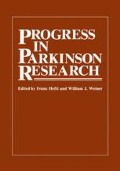Abstract
The turnover of monoamine neurotransmitters in brain should, in theory, be associated with an increased flux of hydrogen peroxide. The H202 arises as a result of the oxidative deamination of the neurotransmitters by monoamine oxidase (MAO).
Access this chapter
Tax calculation will be finalised at checkout
Purchases are for personal use only
Preview
Unable to display preview. Download preview PDF.
References
Adams, J.D., Lauterberg, B.H., and Mitchell, J.R., Plasma glutathione and glutathione disulfide in the rat: regulation and response to oxidative stress. J. Pharmacol. Exp. Ther. 227: 749–754, 1983.
Altar, C.A., Marien, M.R., and Marshall, J.E, Time course of adaptations in dopamine biosynthesis, metabolism, and release following nigrostriatal lesions: implications for behavioral recovery from brain injury. J. Neurochem. 48: 390–399, 1987.
Cohen, G., The pathobiology of Parkinson’s disease: biochemical aspects of dopamine neuron senescence. J. Neural Trans. Suppl. 19: 89–103, 1983.
Gilbert, H.F., Biological disulfides: the third messenger? J. Biol. Chem. 257: 12086–12091, 1982.
Hefti, F., Melamed, E., and Wurtman, R.J., Partial lesions of the dopaminergic nigrostriatal system in the rat brain: Biochemical characteristics. Brain Res. 195: 123–137, 1980.
Hefti, F., Melamed, E., and Wurtman, R.J., The site of dopamine formation in rat striatum after L-dopa administration. J. Pharmacol. Exp. Ther. 217: 18–197, 1981.
Hornykiewicz, O. and Kish, S.J., Biochemical pathophysiology of Parkinson’s disease. In Advances in Neurology, 45: 19–34, 1986.
Maker, H.S., Weiss, C., Silides, D.J., and Cohen, G., Coupling of dopamine oxidation (monoamine oxidase activity) to glutathione oxidation via the generation of hydrogen peroxide in rat brain homogenates. J. Neurochem. 36: 589–593, 1981.
Perry, T.L., Godin, D.V., and Hansen, S., Parkinson’s disease: a disorder due to nigral glutathione deficiency? Neurosi. Lett. 33: 305–310 (1982).
Oshino, N. and Chance, B., Properties of glutathione release observed during reduction of organic hydroperoxide, demethylation of aminopyrine and oxidation of some substances in perfused rat liver, and their implications for the physiological function of catalase. Biochem. J. 162: 509–525, 1977.
Sies, H., Hydroperoxides and thiol oxidants in the study of oxidative stress in intact cells and organs. In H. Sies (Ed.), Oxidative Stress, Academic, London, 73–90, 1985.
Sinet, P.M., Heikkila, R.E., and Cohen, G., Hydrogen peroxide production by rat brain in vivo. J. Neurochem. 34: 1421–1428, 1980.
Slivka, A., Spina, M.B., and Cohen, G., Reduced and oxidized glutathione in human and monkey brain. Neurosci. Lett. 74: 112–118, 1987.
Spina, M.B. and Cohen, G., Exposure of striatal synaptosomes to L-Dopa increases levels of oxidized glutathione, Trans. Amer. Soc. Neurochem., in press, 1988.
Tietze, F., Enzymic method for quantitative determination of nanogram amounts of total and oxidized glutathione: applications to mammalian blood and other tissues. Analyt. Biochem. 27: 502–522, 1969.
Author information
Authors and Affiliations
Editor information
Editors and Affiliations
Rights and permissions
Copyright information
© 1988 Plenum Press, New York
About this chapter
Cite this chapter
Cohen, G., Spina, M.B. (1988). Hydrogen Peroxide Production in Dopamine Neurons: Implications for Understanding Parkinson’s Disease. In: Hefti, F., Weiner, W.J. (eds) Progress in Parkinson Research. Springer, Boston, MA. https://doi.org/10.1007/978-1-4613-0759-4_15
Download citation
DOI: https://doi.org/10.1007/978-1-4613-0759-4_15
Publisher Name: Springer, Boston, MA
Print ISBN: 978-1-4612-8068-2
Online ISBN: 978-1-4613-0759-4
eBook Packages: Springer Book Archive

